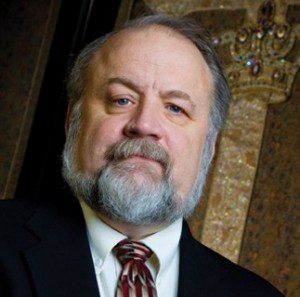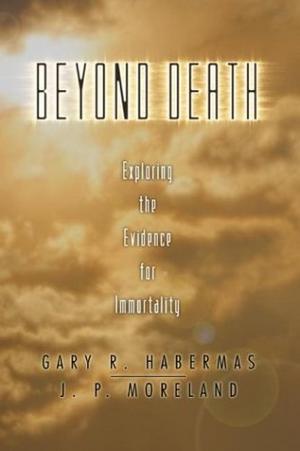
A big reason I wanted this interview was because I’d been hearing things. Things about the “dead.”
I heard that you could verify, with evidence, certain near-death experiences. I heard that a woman named Maria had a severe heart attack and was rushed to the hospital. Then, two days later, while hospitalized in the coronary care unit, Maria had cardiac arrest, and while doctors took action to save Maria’s body, she says she left her body. Maria claims to have found herself on the roof of the hospital, where she noticed a sneaker on the north ledge of the third floor roof. Worn and torn over the little toe, the shoe appeared to have a lace stuck under its heel. Later, after Maria woke up, she told her critical care worker, named Kimberly, what she saw. Kimberly, skeptical of the story, managed to get access to the roof, where she recovered the sneaker, exactly where and as Maria claimed to see it. Kimberly concluded that there was no way Maria could have seen the shoe in such detail unless she was on the roof herself.
Wow.
But are such stories reliable? Responsibly documented? The volume of near-death accounts in the U.S. alone is in the millions, which seems to indicate that some part of this is real. But I don’t want to pretend to believe. I don’t want to do faith on this one; I want to know. Life is short, and who has time for another ghost story? If the afterlife is real and stretches into eternity, some veracity would be nice for once.
So I sought authority. Someone who not only collected stories, but interviewed nurses, doctors, scientists, patients, family members, and confirmed certain near-death stories were initially recorded by a doctor or nurse and were not just some orchestrated attention-grabbers. I wanted someone who had invested serious time recording the facts.
Enter Dr. Gary Habermas.
(Note: At this point, near-death experience will be referred to as NDE or NDEs. Everyone deserves an acronym, especially the “mostly dead.”)
Dr. Gary Habermas is a Distinguished Professor at Liberty University, and is an expert on near-death experience. (His co-authored book is titled, Beyond Death: Exploring the Evidence for Immortality.) Habermas has spent years interviewing doctors, families, and the people who claim NDEs. Dr. Habermas knows that “near-dead” has many meanings, and so he has a clinical version of “dead” that he likes better. He prefers cases that are post-cardiac arrest for more than thirty seconds, because someone with cardiac arrest is brain dead in eleven to twenty seconds. So add ten seconds for good measure, and you’ve got a body with no heartbeat and no brain activity, not just one or the other. At any point after that, if you wake up and have a story to tell, he’ll listen.
***
The Rumpus: Give me something no jury could overturn. What is the most irrefutable, evidential, NDE case you know of?
Dr. Gary Habermas: Well, juries are by no means considered the best deciding bodies. They are lay people. The more impressive thing is when these stories take weight with scientists and doctors and people that are around these near-death situations. So what is believable depends on what the person considers good evidence. There is such an array of cases. There are many versions of “dead.”[1]
 You have a number of extraordinary near-death experiences. NDE being defined as: a state from which a person can reasonably be believed to be close to dying if there were no intervention, say, if your heart isn’t beating or your upper-brain activity is non-existent. Like I was saying, the NDEs that are most evidential are the ones with no measurable heart or brain function. A flat brain. When I say flat, I mean flat on the machine. EEGs only measure upper-brain function.
You have a number of extraordinary near-death experiences. NDE being defined as: a state from which a person can reasonably be believed to be close to dying if there were no intervention, say, if your heart isn’t beating or your upper-brain activity is non-existent. Like I was saying, the NDEs that are most evidential are the ones with no measurable heart or brain function. A flat brain. When I say flat, I mean flat on the machine. EEGs only measure upper-brain function.
I have had reported to me two cases where the person who qualifies as near-death was being carried to the ambulance on a stretcher, and was then slid into the ambulance. Lying prone on the stretcher and in no shape to witness what is around them, they have later claimed to be above their bodies watching the scene unfold. They said—this is me paraphrasing—“Well, I was up above my body and watched them load me. I was floating over the ambulance. There is a number printed on top of the ambulance.” And then they properly give the number on the top of the ambulance.[2]
Then you have the NDE of a young girl who nearly drowned and was without heartbeat for nineteen minutes. And so you know, the brain and body’s reaction to cardiac arrest is the same with no heartbeat, so my requirements for “dead” are good here.
Rumpus: Okay.
Habermas: So they brought her into the ER. She was profoundly comatose with no upper-brain activity, and they hooked her up to machines and that was all they could do. By the way, I got this account from the presiding doctor working on the resuscitation—I talked to him for hours—and he said they would give her about a one in ten thousand chance of living without impaired brain function, and only a one in one thousand chance of living at all. But then, a few days later, she came-to spontaneously. And what I mean by spontaneously, is that she came-to without a specific procedure. One minute she was lying in coma, and the next, she opened her eyes. Then she looked up, and seeing the doctor, said, “You’re the guy that saved me. Thank you. Where is the other doctor, the tall doctor without the beard?”
The presiding doctor was flabbergasted. He said, “I’ll go get him for you.” So he walked down the hall, grabbed the other doctor, and they came back and took notes, while the girl told them what she had experienced over the last days. She said an angel had escorted her to her parents’ home a couple of nights earlier.[3] With the doctors listening and note-taking, the girl went on to describe the scene at her house that evening, where her father was sitting and what he was doing, the same thing for her sister and brother, and when the girl got to her mom, she said she was in the kitchen making dinner.
Here the doctor broke in and asked, “What was she making for dinner?”
And the little girl said, “Roast chicken and rice.”
So later, when the parents arrived at the hospital, they were thrilled to see their daughter alive, after which point, the presiding doctor pulled the family aside and interviewed the parents as to the details of the previous night—where they were sitting in the house, what was being made for dinner, and so on. As it turns out, the daughter had every single detail right. All of it.
That’s one of the more complicated ones.
Rumpus: That’s good. So what do professional skeptics or naturalists say to refute a story like this?
Habermas: Naturalists have had to adjust their line for many years. Usually, they would say things like, “Come on, this could happen from oxygen deprivation, cerebral anoxia, from a stroke, from temporal lobe epilepsy; it could come from being near-death and these are the machinations of a dying brain.” Doctors say that when you stimulate the right temporal lobe, people see things like flashes of light and darkness, and so that could be the tunnel of light that many people claim to see. Things like that.
 Well, let’s just grant all of their hypotheses. Let’s grant that there are natural reasons, maybe high temperature, or additional medicines that cause hallucinations. Let’s grant all of those things. Yes, let’s say that one or more of those could cause strange visual data like what you’re describing. But here is the Achilles heel: as much as I can present evidence that these people are seeing things that they couldn’t see if they were totally conscious, awake, and sitting on their bed in the hospital, if people are producing evidence, especially at a distance, then none of those theories can account for it. Because they are offering subjective responses—maybe things are going on inside their head—and I’m offering objective responses that have nothing to do with what is inside their head.
Well, let’s just grant all of their hypotheses. Let’s grant that there are natural reasons, maybe high temperature, or additional medicines that cause hallucinations. Let’s grant all of those things. Yes, let’s say that one or more of those could cause strange visual data like what you’re describing. But here is the Achilles heel: as much as I can present evidence that these people are seeing things that they couldn’t see if they were totally conscious, awake, and sitting on their bed in the hospital, if people are producing evidence, especially at a distance, then none of those theories can account for it. Because they are offering subjective responses—maybe things are going on inside their head—and I’m offering objective responses that have nothing to do with what is inside their head.
So, to the extent that we have evidence, the naturalistic response is troubled. In reality, most of them don’t dispute this kind of evidence. These are cases that no one can explain naturally.
Rumpus: So these cases are just ignored?
Habermas: Usually we’re overpowered by our worldview. So if a person says, “Well, I’m sorry, I’m going to put that on the back burner until I am better able to respond,” or, “I’m going to hold onto it,” what they are saying is that they want to stay a naturalist and they seem to hope they never have to return to this sort of evidence.
Rumpus: Have your studies of NDEs altered your worldview?
Habermas: When you interview as many people as I have, there are moments where you are sitting there and think, Wow. There really is something going on over here. So, over time, it alters your view on how upset you should be about a bad check-up. There is a practical, calming thing that can come about because the person that has the NDE is often extremely calm about these subjects when they return. They have been somewhere and now know it to be true (to them, at least), and you can sense that.
Rumpus: Do NDEs back up any certain religion?
Habermas: NDEs are not worldview-specific. They claim naturalism is wrong, I suppose, but they don’t choose between Hinduism, Buddhism, Judaism, Christianity, etc. All of those belief systems can say “amen” to NDEs. NDEs may contribute to knocking out naturalism, but they don’t tell you who is right.
Now, there are NDEs where people report meeting an angel. Or, someone says, “I died, and Jesus told me that I was going back; it wasn’t my time to die yet.” But then there are also accounts of people saying, “I died, and I saw Shiva.” Or, “I saw Buddha.” There are a lot of cross-religious NDEs.
But I have a rule I apply to all NDEs. And the rule goes like this: I only accept NDE data when there is evidence that the person saw what they said they saw—the number on top of the ambulance, what your mother made for dinner, etc. But, you’re going to look a long time before you find a case that is both evidential and makes the case for a specific religion. Many times, people will say “there was a warm light and it accepted me,” and then they will say, “This light was…” and when you get to that point, it’s natural that the person is going to supply the name of the person that fits their worldview. It’s is not often that the entity will walk up to the person and introduce themselves as Moses or Shiva.
Rumpus: How about NDEs which account hell?
Habermas: There are hell-like NDEs which could fairly be called hell. There are people that report being in a lake of fire. There are people who claim being in a world like Sheol from the Old Testament, where there are spirit creatures walking around, head down, not paying attention to anything. There are also NDEs where people are in a state of depression or anxiety. All of those cases together are only a small percentage, maybe five percent. The fact that most people have positive NDEs is one of those things that seem to contradict what Christians would expect. But mostly, people don’t have any sort of evidence that they were either in heaven or hell. Like when the girl said that an angel took her to her home. There is no test for that.
Rumpus: What about people who are “dead,” but then don’t have an NDE?
Habermas: In follow-up interviews, sometimes with really precise data, in clinical psychological or medical studies, anywhere from a quarter to a third, to two-thirds of the people who have come close to death report some sort of NDE. So it’s more common than you think. But what about the smaller numbers?
 To me, that is to be expected and there are several reasons. One is a medical reason. When people have a heart attack involving a cardiac arrest, they often suffer from short-term memory loss. So I almost expect people won’t remember anything. But that does not present any evidential issues disproving NDEs.
To me, that is to be expected and there are several reasons. One is a medical reason. When people have a heart attack involving a cardiac arrest, they often suffer from short-term memory loss. So I almost expect people won’t remember anything. But that does not present any evidential issues disproving NDEs.
In one study by cardiologist Michael Sabom, there are a number of folks in his research who have had multiple near-death states, and in his study of over one hundred people, there are people who had an NDE once or twice but did not other times. So that would seem to indicate that it depends on what state you are in or what medicine you are on.
Rumpus: So what can we know for certain about NDEs?
Habermas: I don’t think NDEs allow us to say as much as people might expect. I think we are limited by what we can say about the data. I think the data seems to say that people have consciousness of some form beyond the initial stages of death. I won’t say NDEs indicate eternal life or the truth of one religion, but NDEs seem to be evidence that a portion of our personality can survive at least the initial moments of bodily death. We may not be able to say it survives final death although there are a set of arguments that indicate that it survives biological death as well. I probably shouldn’t get into those.
Rumpus: You should! You are saying that there are claims that we can know something about post-death? How can we have any such information if the dead, well…stay dead?
Habermas: Well, you know that neurosurgeon from Lynchburg?
Rumpus: I do.[4]
Habermas: During Alexander’s NDE, he reported meeting someone who was his birth sister, someone who he never met in real life and who had already passed on. So he is claiming to have interacted with someone who is post-death.[5]
There are some really strange ones like that, some Twilight Zone things. They are not as evidential, but they give us the idea that perhaps people are alive in some state after death.
Rumpus: I appreciate your time and all of your research.
Habermas: Thank you. Can you do me a favor, Chris?
Rumpus: Sure.
Habermas: Can you shoot me a copy of the interview before it runs? I won’t change anything, except I want to ensure you don’t use words like “proof” and “fact,” because we can only know certain things, and in my field we don’t use certain words. I almost never use the word “proof” when talking about this subject. I want to ensure the integrity of the research.
***
[1] This is where Habermas goes into detail describing the kind of “dead” he prefers to deal with, and I think to myself, We’re off to a good start. Habermas is not ready to shock me with a killer story. He wants to clarify, to be precise, to define terms. This occurs constantly throughout the interview so that I won’t, he says, misinterpret terminology. Habermas repeatedly apologizes for going into such background detail before ever nearing an answer to my questions. I keep telling him that it’s fine. This is what I want: someone who won’t take leaps of faith.
[2] At this point, the skeptic in me wonders if the ambulance also has the number printed on the side. But then the believer inside me can’t figure out how someone who just had a heart attack, or similarly terrifying experience, could wake up and have the wherewithal to lie about an ambulance number. NDEs aren’t like Bigfoot claims, where you just go on a hike and come back with a well-rehearsed story; no, for a Habermas-worthy NDE, you have to clinically die and then get lucky enough to live again. It’s hardly something you premeditate.
[3] Here, Habermas notes that there is no test for an angel. This is just what the girl decided the being was.
[4] Habermas is referring to Eben Alexander, a neurosurgeon from Lynchburg, Virginia (where we are having this interview and where we both live, further evidence of the profluent nature of NDEs) who had an NDE brought on by a rare form of E. coli infection/meningitis. His brain was totally shut down. He was in a coma for seven days, and the family was bracing for the unthinkable act of letting him go when he woke up on his own. Dr. Alexander’s story of his seven day journey spent eleven weeks atop the New York Times nonfiction bestseller list. Alexander calls his NDE a perfect storm, because of his special area of expertise prior to the NDE—fifteen years as a neurosurgeon at Harvard Medical. His book is called Proof of Heaven.
[5] I read Proof of Heaven and learned that Eben Alexander, who was adopted, had been trying to contact his birth family before his NDE. After recovering, one of his siblings mailed him a photo of one of his birth sisters, whom he recognized as the “guardian angel” from his NDE.
Close to the time of this interview, I went to a party in an upscale Lynchburg neighborhood, where I met a doctor closely associated with Dr. Alexander’s story. According to this doctor, Alexander’s condition is exaggerated in Proof of Heaven. The doctor said that the crew working on Alexander always knew he was going to recover, whereas in the book it seems as if they were about to say their final goodbyes. While I am not ready to say what this means for my interview, it certainly throws an all-too-familiar shadow of doubt over the extraordinary.




